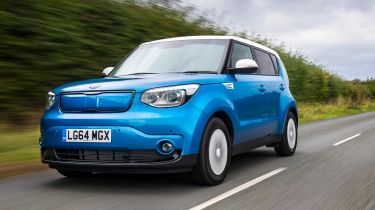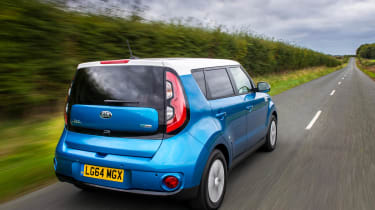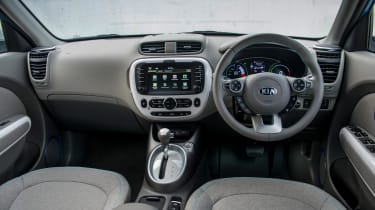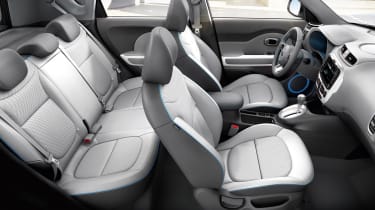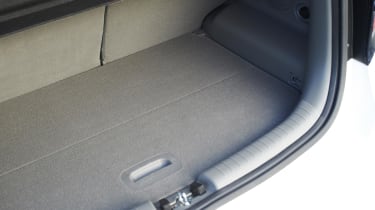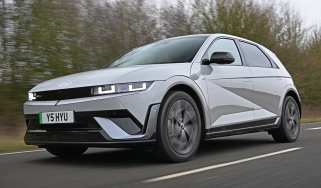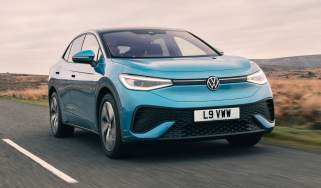Kia Soul EV hatchback (2014-2018)
“The Kia Soul EV is a competent, well made and appealing electric car, though it’s expensive when compared to its rivals”
Pros
- Lots of standard equipment
- Practical & easy to drive
- Good range
Cons
- Expensive to buy
- Interior a bit dull
- Other EVs have longer ranges
If you’re considering an electric car, the Kia Soul EV deserves to be on your shopping list, alongside the Nissan Leaf, Renault ZOE and BMW i3. It’s broadly similar to the standard Soul hatchback, but instead of a petrol or diesel engine there’s a 109bhp electric motor and 27kWh lithium-ion polymer battery pack. These give the Soul EV a claimed range of up to 132 miles and recharging the batteries should take around four to five hours at home if you have a fast charger installed.
The Soul EV is comfortable and easy to drive, with adequate performance, particularly at speeds below 60mph. Interior space is also decent and the boot is of a good size, while standard equipment is very generous indeed. Although the EV is roughly twice the price of the standard Soul, you can knock £4,500 off its price straight away thanks to a Government grant. In the current medium-sized EV market, it does seem expensive though: over £10,000 more than a basic Renault ZOE, around £4,000 more than a Nissan Leaf, and only £2,500 or so off an entry-level BMW i3 – a car we rate as the best in its class. There is no separate battery lease option for the Soul EV.
MPG, running costs & CO2
Once you’ve signed up to buy your Soul EV, you’ll face very few other bills. No road tax, no petrol or diesel refills (obviously), minimal company-car tax liability (7%) and a reasonable group 19 (out of 50) insurance rating.
Charging the Soul EV’s batteries can be done in one of three ways: a standard three-pin plug will take 12 hours to give a full charge, a fast charger should take around four to five hours, while a rapid public charging station will take 33 minutes to replenish the batteries to around 80%. Public charging stations typically offer fast or rapid charging and you can also get a fast ‘wall box’ installed at home, for which Government grants are also available. The Soul EV comes with two types of charging cables to connect to your household supply or a dedicated charging point. A domestic wall charger for home installation is sold as an option.
Engines, drive & performance
If you’ve ever driven a petrol or a diesel Soul, you’ll know roughly what to expect from the Soul EV. It’s comfortable and generally decent to drive, although the steering feels lifeless and artificial and the turning circle isn’t as tight as a BMW i3’s. The Soul EV’s 0-62mph time of 10.8 seconds is reasonable enough and the surge of electric power means it feels faster than that figure suggests, particularly when accelerating from rest to 40mph.
The Kia Soul EV is remarkably easy to drive – it’s not too far removed from the petrol and diesel versions, in fact. If you’re considering the Kia as your first EV, there’s nothing to intimidate here.
Interior & comfort
Because the Soul EV is a modified version of the standard Soul, its dashboard is pretty conventional – especially when compared to purpose-built electric rivals like the BMW i3.
More reviews
However, everything feels well made and the materials used are of a high quality, with digital dashboard dials and light-coloured plastics. Just don’t expect an ultra-modern interior to match the forward-thinking electric motor and battery setup.
Kia is remarkably generous when it comes to kit: all Soul EVs come with sat nav, keyless entry and go, heated seats and steering wheel, a DAB radio and a reversing camera.
Practicality & boot space
Assuming you have somewhere off-street to park and charge the Soul EV and your regular journeys are short enough for its range, there’s no reason not to buy one. Unlike some electric cars – like the BMW i3, for example – the Soul EV offers five, rather than four, rear seatbelts, meaning you won’t have to make any major compromises if you’re used to a conventional hatchback.
The Soul EV’s 132-mile range is competitive, but be aware the Nissan Leaf, Renault ZOE and BMW i3 can all go further, assuming you upgrade their battery packs.
Interior space in the Soul EV is good. There’s a little less legroom in the back than in the standard Soul due to the battery storage, but by angling the rear seat bases differently, Kia has negated the impact of this. Similarly, the Soul EV’s boot is 281 litres (the standard car gets 311 litres), but this space has been taken from the underfloor storage, so you shouldn’t really miss it. It’s more than you get in a BMW i3 (260 litres), but less than a Nissan Leaf (370 litres) or Renault ZOE (338 litres).
Reliability & safety
Kia is famous for its seven-year/100,000-mile warranty, which is over twice as long as the industry average. It’s also full transferrable, so secondhand buyers can also benefit. The Soul EV’s batteries get the same guarantee.
Independent safety testing body Euro NCAP gave the Kia Soul EV four out of five stars. It posted strong results in its adult and child occupant assessments, but garnered more average results where pedestrian protection and safety assistance technology were concerned. The former is due to its bluff front end, while the latter is down to the Soul EV not being available with autonomous emergency braking (AEB).
Price, value for money & options
As the most expensive model in the Soul range, standard equipment is very generous for the EV, so you shouldn’t need to add many goodies. If you ever want to sell your Soul, do bear in mind the EV version is likely to depreciate faster than an equivalent petrol or diesel model. This is a trait many electric cars suffer from at present.

